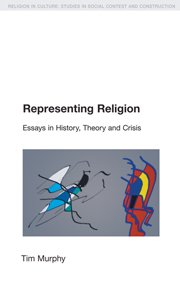Book contents
- Frontmatter
- Dedication
- Contents
- Acknowledgements
- Chapter 1 The “Crisis of Representation” and the Academic Study of Religion
- Part I Phenomenology, Consciousness, Essence: Critical Surveys of the History of the Study of Religion
- Chapter 2 “Individual Men in their Solitude”: A Critique of William James' Individualistic Approach to Religion in The Varieties of Religious Experience
- Chapter 3 The Concept of “Essence-and-Manifestation” in the History of the Study of Religion
- Chapter 4 The Concept of “Development” in Continental Geisteswissenschaft and Religionswissenschaft: Before and After Darwin
- Chapter 5 The “Transcendental Pretense” and Eliade's Humanist Hermeneutics
- Part II Towards a Nietzschean Semiotics of Religion
- Notes
- Bibliography
- Index of Subjects
- Index of Names
Chapter 3 - The Concept of “Essence-and-Manifestation” in the History of the Study of Religion
from Part I - Phenomenology, Consciousness, Essence: Critical Surveys of the History of the Study of Religion
- Frontmatter
- Dedication
- Contents
- Acknowledgements
- Chapter 1 The “Crisis of Representation” and the Academic Study of Religion
- Part I Phenomenology, Consciousness, Essence: Critical Surveys of the History of the Study of Religion
- Chapter 2 “Individual Men in their Solitude”: A Critique of William James' Individualistic Approach to Religion in The Varieties of Religious Experience
- Chapter 3 The Concept of “Essence-and-Manifestation” in the History of the Study of Religion
- Chapter 4 The Concept of “Development” in Continental Geisteswissenschaft and Religionswissenschaft: Before and After Darwin
- Chapter 5 The “Transcendental Pretense” and Eliade's Humanist Hermeneutics
- Part II Towards a Nietzschean Semiotics of Religion
- Notes
- Bibliography
- Index of Subjects
- Index of Names
Summary
Derrida tells us of Hegel that he “summed up the entire philosophy of the logos. He determined ontology as absolute logic; he assembled all the delimitations of philosophy as presence; he assigned to presence the eschatology of parousia, of the self-proximity of infinite subjectivity” (Derrida 1974, 24). In order to understand the historical construction of the field of Religious Studies, it is necessary to see that it was Hegel and these Hegelian motifs which provided the philosophical foundations of early Religionswissenschaft, as they were modified by Dilthey, appropriated by such figures as C. P. Tiele, Chantepie de la Saussaye, and Rudolph Otto, and through them, passed on to the school known as “classical phenomenology of religion,” i.e., those seminal figures in the history of the field, W. B. Kristensen, Gerardus van der Leeuw, Joachim Wach, and Mircea Eliade. Religionswissenschaft grew out of Religionsphilosophie, and that philosophy of religion was Hegelian philosophy of religion. These Hegelian motifs have become historically sedimented into the field such that they color much of its technical vocabulary (albeit in modified form). They are the invisible, yet ubiquitous, tools which allow (or force?) us to see diverse geographic and historical plurality as grounded in an essential, ahistorical unity, to render out of the religio-cultural “many,” the “one” “religion” (singular), homo religiosus, etc. The phenomenology of religion, by way of its appropriation of Hegel, in other words, turned Religious Studies into a variation of the “metaphysics of presence.”
- Type
- Chapter
- Information
- Representing ReligionEssays in History, Theory and Crisis, pp. 54 - 77Publisher: Acumen PublishingPrint publication year: 2007

